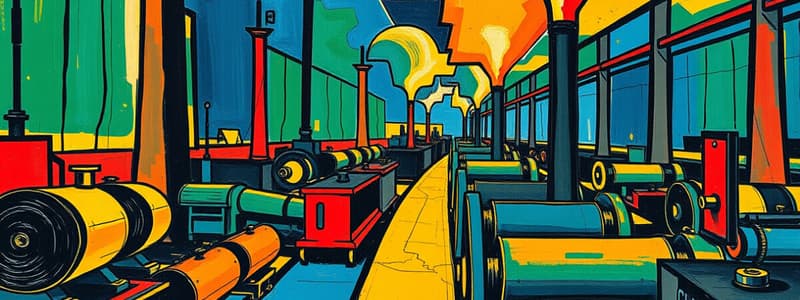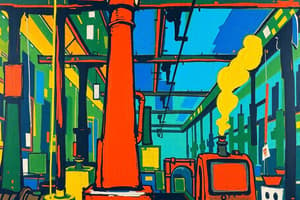Podcast
Questions and Answers
The shift toward mass production affected consumers by...
The shift toward mass production affected consumers by...
- Making goods less expensive (correct)
- Creating a greater variety of goods
- Making goods that lasted longer
- Creating fewer luxury goods
During the Industrial Revolution, who demanded reform?
During the Industrial Revolution, who demanded reform?
- Professional people
- Factory owners
- Working class people (correct)
- Government officials
The term slum means...
The term slum means...
- A noisy, busy city filled with many residents
- A busy neighborhood with apartment buildings
- An industrial neighborhood containing many factories
- A crowded area with run-down housing and high poverty (correct)
New laws that were passed during the Industrial Revolution helped city residents by...
New laws that were passed during the Industrial Revolution helped city residents by...
Based on the graph, a conclusion that can be drawn about the textile industry is that...
Based on the graph, a conclusion that can be drawn about the textile industry is that...
Workers were attracted to industrial cities because...
Workers were attracted to industrial cities because...
By paying low wages, factory owners were able to...
By paying low wages, factory owners were able to...
Why were factory conditions so bad at the start of the Industrial Revolution?
Why were factory conditions so bad at the start of the Industrial Revolution?
Why did it take so long for working class people to fight for improved conditions?
Why did it take so long for working class people to fight for improved conditions?
Early in the Industrial Revolution, factory owners employed many...
Early in the Industrial Revolution, factory owners employed many...
What was the main reason for poor living conditions in cities?
What was the main reason for poor living conditions in cities?
Factory employees worked _____ days a week.
Factory employees worked _____ days a week.
What was the biggest effect that new technology had on farm workers?
What was the biggest effect that new technology had on farm workers?
What development most likely explains the information in the chart about the population of Manchester, England?
What development most likely explains the information in the chart about the population of Manchester, England?
Flashcards are hidden until you start studying
Study Notes
Impact of Mass Production
- Mass production made goods less expensive and created a greater variety of products.
- Led to a decrease in luxury goods and an increase in the longevity of consumer products.
Reform Demands During Industrial Revolution
- The working class predominantly demanded reforms, while factory owners and government officials had different interests.
Definition of Slum
- A slum is characterized as a crowded area with dilapidated housing and high poverty levels, contrasting with busy urban environments.
Legal Reforms
- New laws during the Industrial Revolution improved the standard of living in cities and provided children with school attendance options.
Textile Industry Insights
- Graphs indicated that textile factories had more jobs suited for children, revealing unsafe working conditions and low pay.
Attraction to Industrial Cities
- Industrial cities attracted workers due to higher wages, better educational opportunities, and cultural offerings compared to rural life.
Factory Owner Practices
- By paying low wages, factory owners maximized profits despite potential negative effects on workforce morale and safety.
Poor Factory Conditions
- Initially poor factory conditions were primarily due to the absence of protective laws for workers.
Delayed Worker Rebellion
- Working-class protests for better conditions were slow due to worker powerlessness and gratitude for employment.
Employment Demographics
- Early industrial factories heavily employed children and women, leading to concerns over their welfare and labor standards.
Urbanization and Poor Living Conditions
- Rapid urbanization led to poor living conditions as cities were unprepared for the influx of new workers from rural areas.
Job Losses Due to Technology
- New technology in agriculture caused widespread job losses among farm workers, highlighting the transitory nature of employment during industrialization.
Population Growth in Manchester
- Population growth in Manchester was largely driven by migration from rural areas seeking work and opportunities in industrial settings.
Studying That Suits You
Use AI to generate personalized quizzes and flashcards to suit your learning preferences.




